Through August
Free
Woodson African American Museum of Florida
St Petersburg
Details here
There’re some strong engaging artworks currently at the Woodson African American Museum of Florida in St Pete.
They’re by the artist Traci Mims in her solo exhibition Give Us The Sun. She gave an artist talk during opening night which unfortunately I arrived late at.
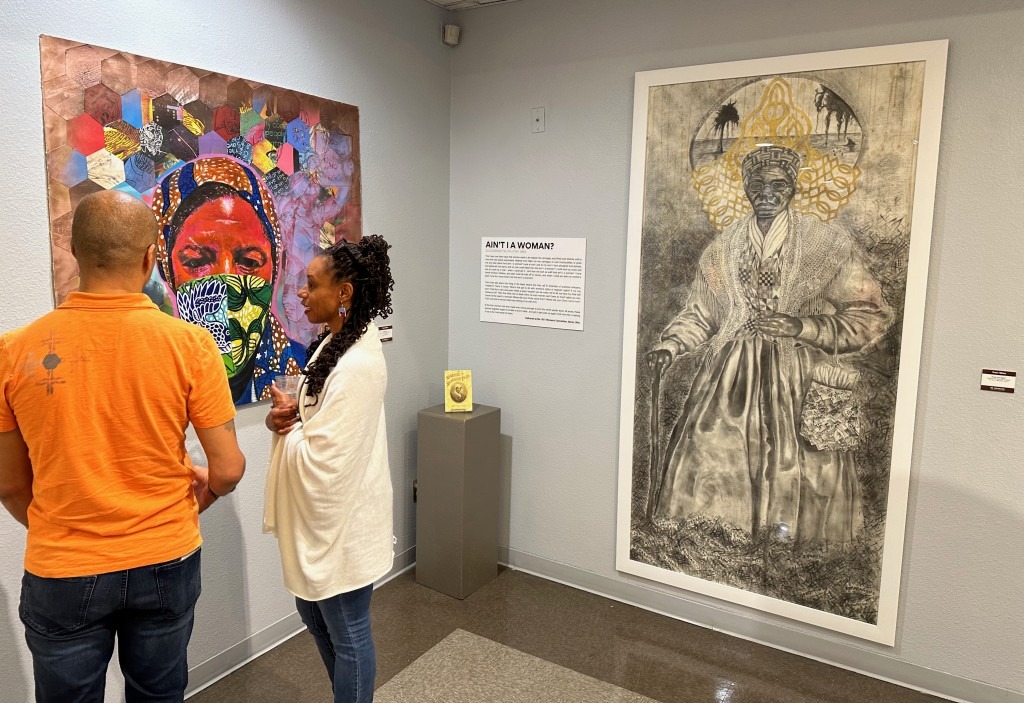
Mims is a native of St. Petersburg, currently living and working in Atlanta, Georgia. She studied at Florida A&M University and Tyler School of Art at Temple University, where she received her MFA degree with a concentration in printmaking.
This printmaking focus is evident, and highlighted in the exhibition with several woodblock prints, including a sample of a woodblock.
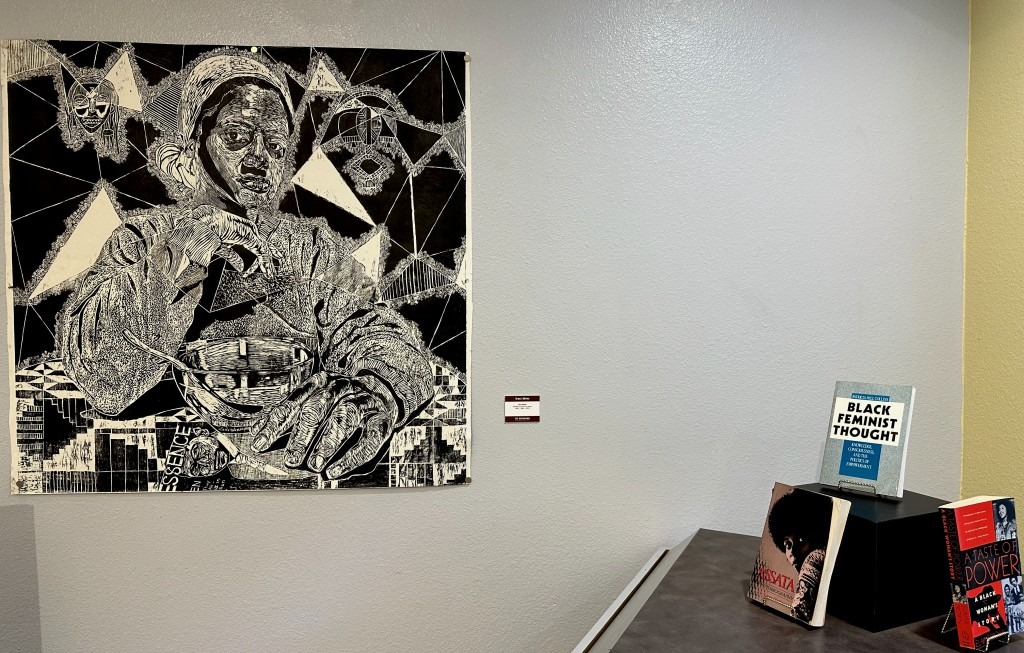
The woodblock prints are Hot Grits, Jacob’s Ladder, Flowers for Their Stripes, Pray, Remember the Revolution and punctuated with We Are Warrior Goddesses, which is the original woodblock itself.

It would have been nice if the print from this woodblock was included, but still, the 48”H x 24”W woodblock stands autonomous, plenty capable of telling the story with its carved lines, gouged textures, shapes, patterns and the blackness of the ink bringing out the depths of the cuts.

Hot Grits, 48”x48”, might be my favorite with its scale, overall busyness and layered meanings.
The protagonist dominating the center, looking directly out with one elbow on the table, hand bent at the wrist under her chin as if pondering our presence as we ponder her. Her other arm is on the table next to the bowl of grits, hand resting on a copy of Essence magazine.
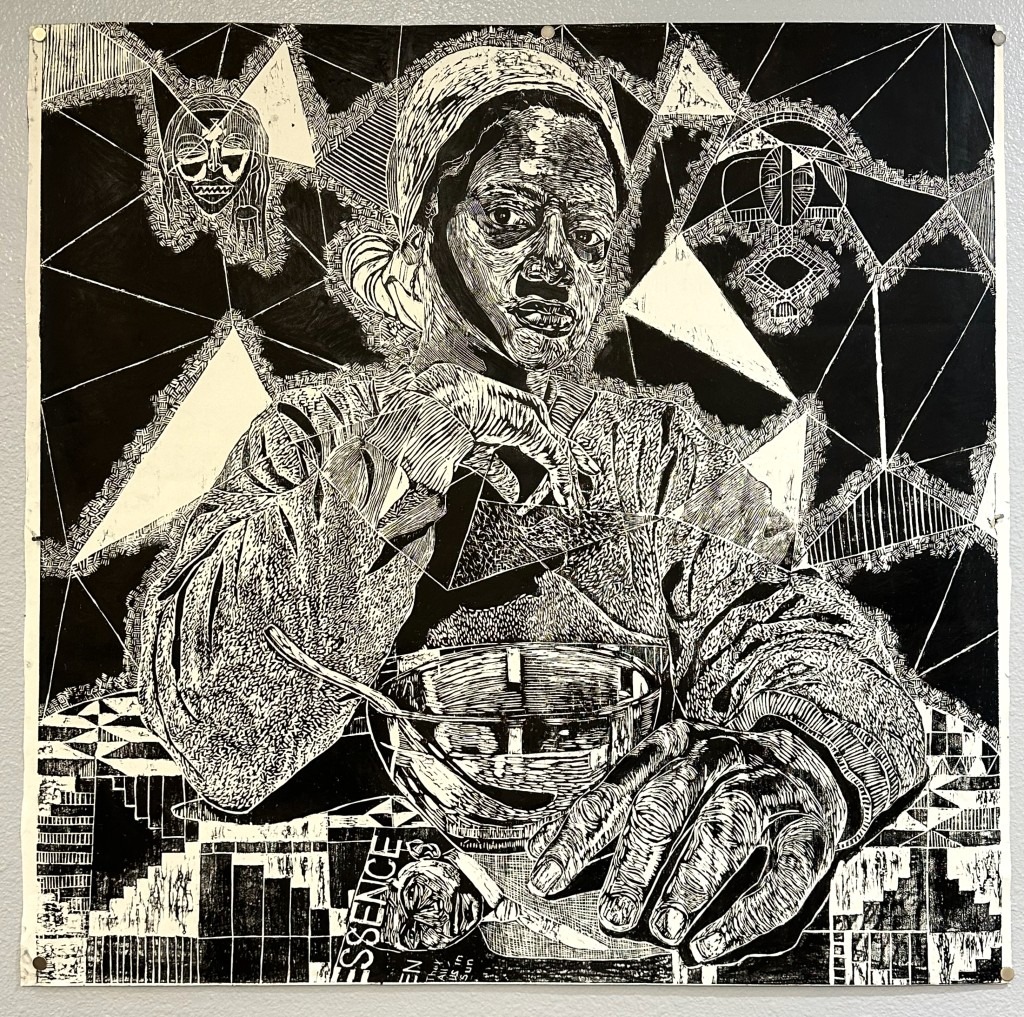
The background is crisscrossed lines forming geodesic dome-like triangles, some overlapping the upper torso, traditional ancestral masks flanking her head. The round table she is sitting at is covered in a quilt-patterned tablecloth. There’s a crosshatch halo line weaving through, linking all the elements.
This is a straightforward statement of being, of an existence in a long deep history.
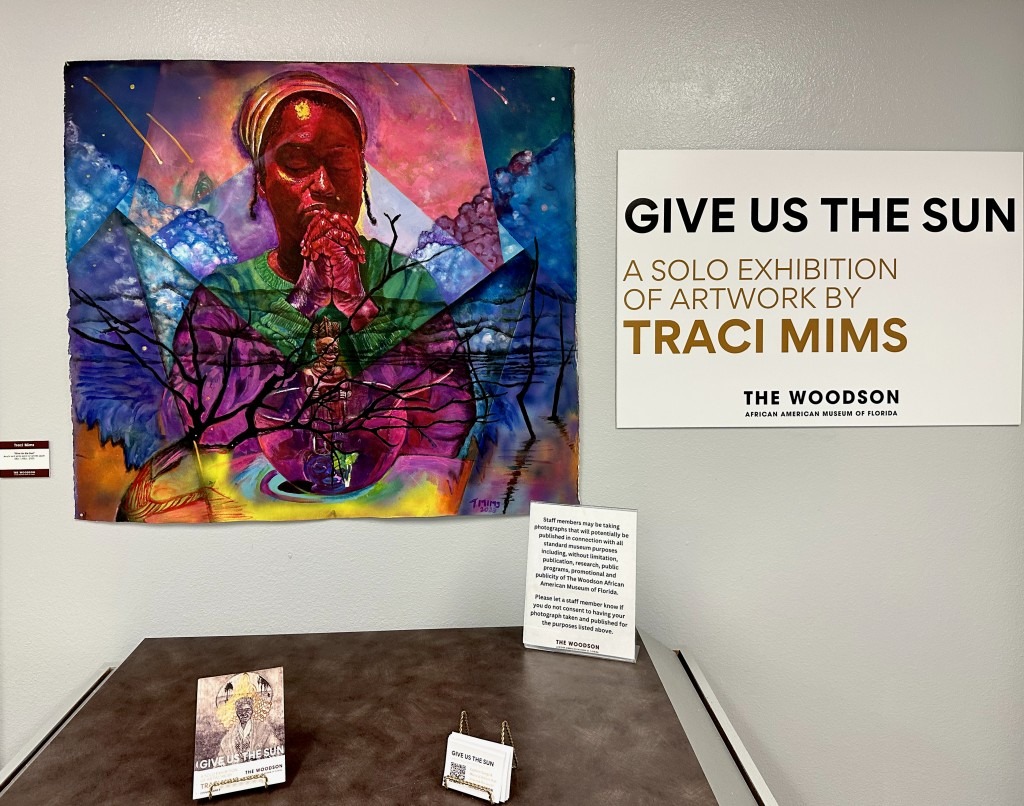
Besides woodblock prints, the exhibition of 18 works also samples Mims’s large output in other medias – drawings, paintings and collage. She had this to say about her works. . . My art addresses subjects related to Black identity through the use of symbolic imagery, cultural allegory and social realism.
This use of social realism follows a style developed in the 1930s when artists wanted to make art accessible to a wider public while calling attention to plights and realities of the working class and less privileged populations.

Mims is an aesthetic descendent of this movement, and of social realist artists like Elizabeth Catlett whose work bring to light issues and experiences of women and African Americans.
Not only that, Catlett also worked in woodcuts, linocuts, lithography and screen prints and has a strong portfolio from her time at the Taller de Gráfica Popular (People’s Graphic Workshop) in Mexico City.

Across from the gallery entrance stand two life-size drawings. On the right is Freedom Rider, with Truth and Lights on the left. Both are graphite drawings with gold and silver leaf on paper.
Freedom Rider is portrait of John Lewis, who confronted racism directly and played an integral part in the Civil Rights movement. Truth and Lights is portrait of Sojourner Truth, fierce advocate for abolition, African American civil rights, women’s rights and alcohol temperance.
Displayed next to Sojourner Truth’s portrait is her book, Narrative of Sojourner Truth, first published in 1850 where she recounts her life, beginning with being born into slavery in rural New York.
There’s a campaign to put Harriet Tubman on the twenty dollar bill. I think maybe have Sojourner Truth on the ten.

The Give Us The Sun exhibition keeps alive this historical narrative, reminding viewers that this is still very much a contemporary issue with pieces documenting current protests and struggles.

“I can’t believe I’m still protesting this shit.” – from one of the smaller images of a protestor in a honeycomb pattern collaged onto a larger painting of Keenan Anderson, whose death was caused by the Los Angeles police restraining, then tasering him six times in 2023. Anderson is cousin of Black Lives Matter co-founder Patrisse Cullors.
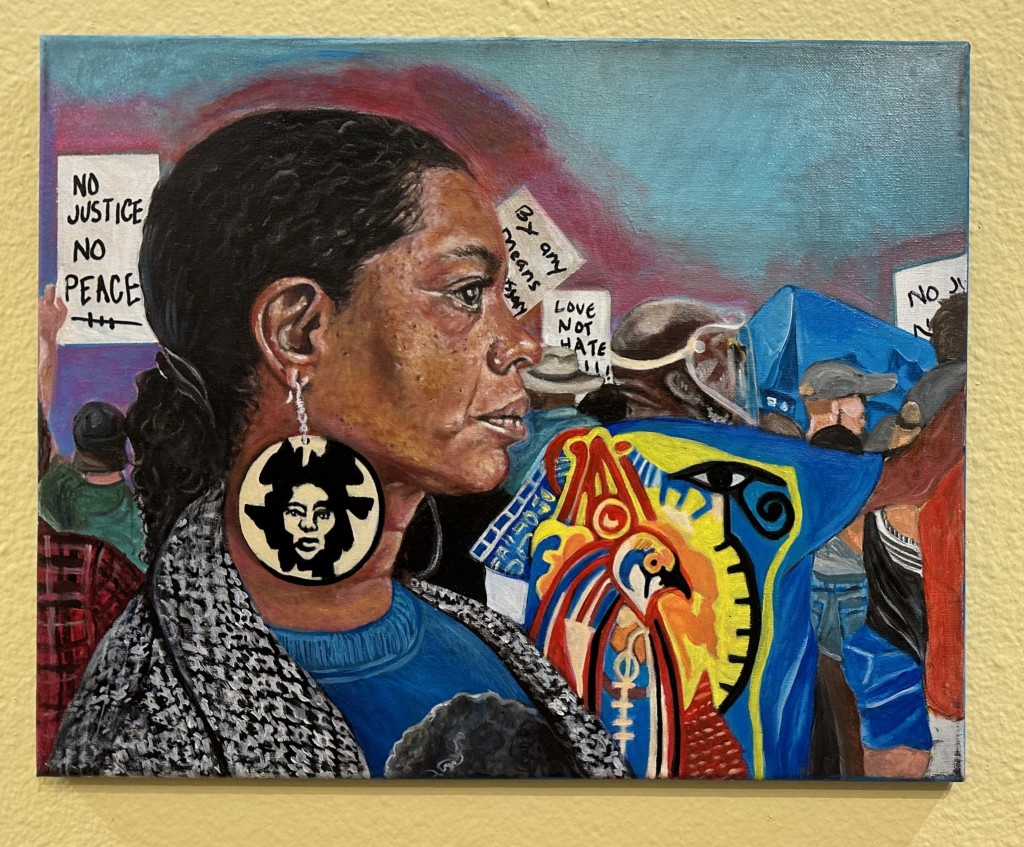
Two smaller paintings reiterate this – I Protest #1 and I Protest #2 show the artist midst other protesters. #1 is her profile from the right, and #2 is her profile from the left. Her matching earrings prominent, a medallion with black and white image of what could be a self-portrait with hair like a lion’s mane.
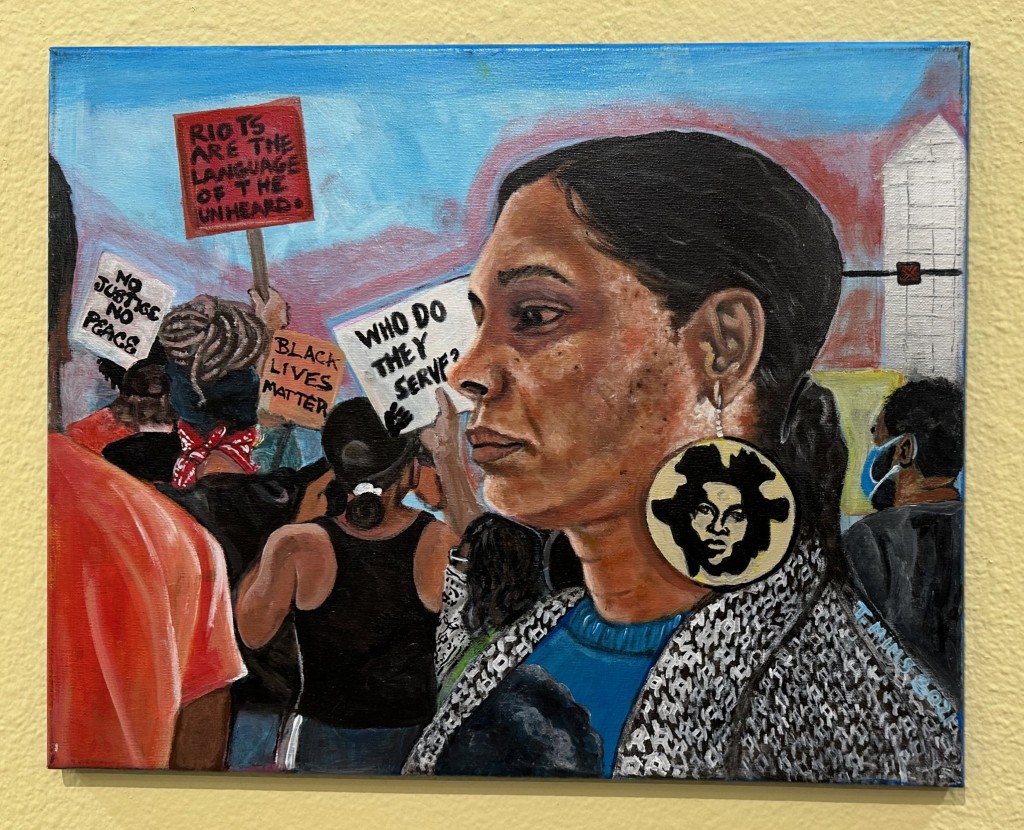
Strategically placed throughout the gallery are books in direct correlation to the nearby artworks, like the Narrative of Sojourner Truth mentioned above. This is significant as the setting in the Woodson’s gallery is also a library – one whole wall is lined with books telling Black history.
This is a history that’s not taught in many schools, or available in libraries, yet some in government are intent on rulings to further white-wash, ban or censor books relating to race and identity.
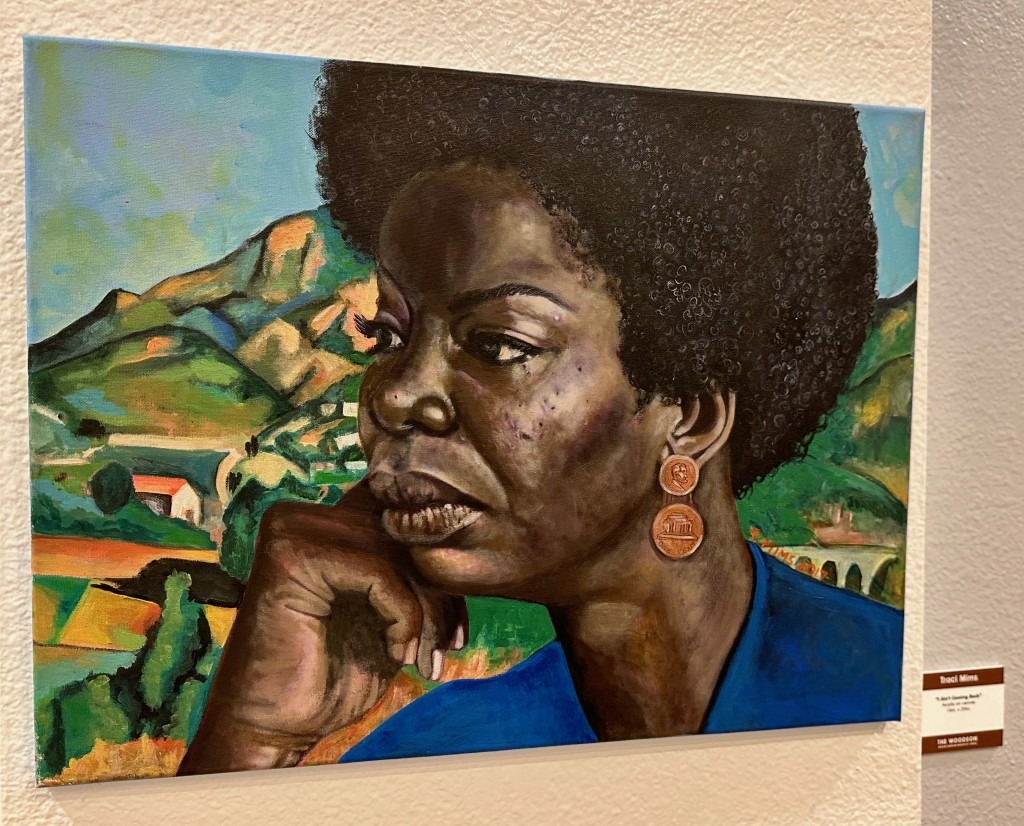
There is one interesting landscape piece installed near the bookshelves – a Nina Simone portrait wearing copper Lincoln penny earrings in a Cézanne-esque mountain backdrop. Titled I Ain’t Coming Back, it hints at a bigger story of exodus.
Simone wrote and performed “Mississippi Goddam” as her response to the horrific events of the 1960s, in particular the killing of four young Black girls in a white supremacist terror attack, and the murder of Medgar Evers, a distinguished World War II veteran and Civil Rights activist. Many of the southern states banned the song and radio stations broke her records before sending them back to her.

The worsening racial situation and disrespect compelled Simone to leave United States, following the footsteps of Eartha Kitt, James Baldwin, W. E. B. Du Bois, Josephine Baker, Tina Turner and many others who, wholly or in part due to racism, left the United States to find greater acceptance and success elsewhere.

Traci Mims’s exhibition provides a real sense of humanity. The faces of each person show lines drawn from living. Every person portrayed has walked, some are still walking this planet.
Every single one left their footprints – some for others to follow, some simply as an imprint of their presence, and determination for freedom and autonomy.
instagram.com/traci_mimsartist




